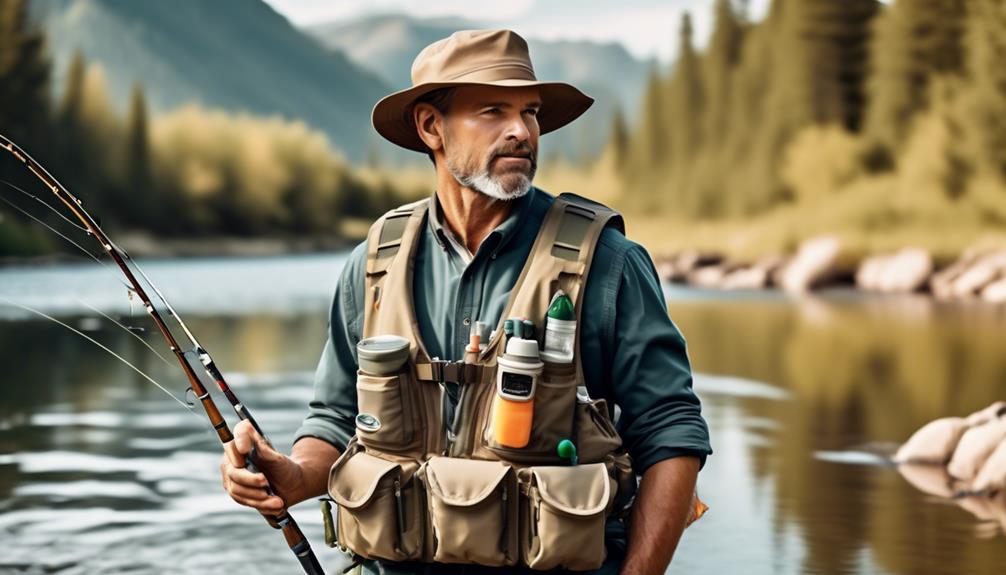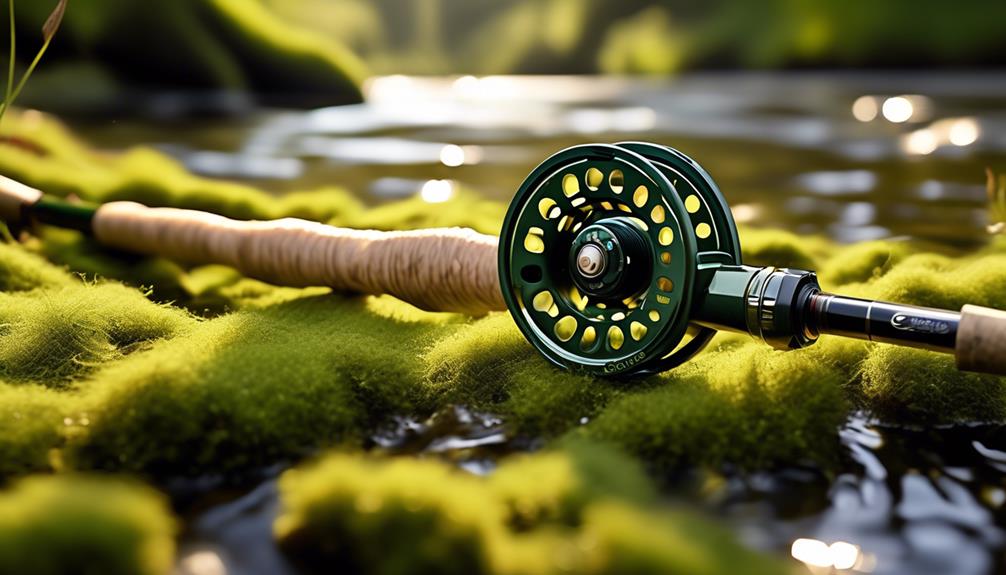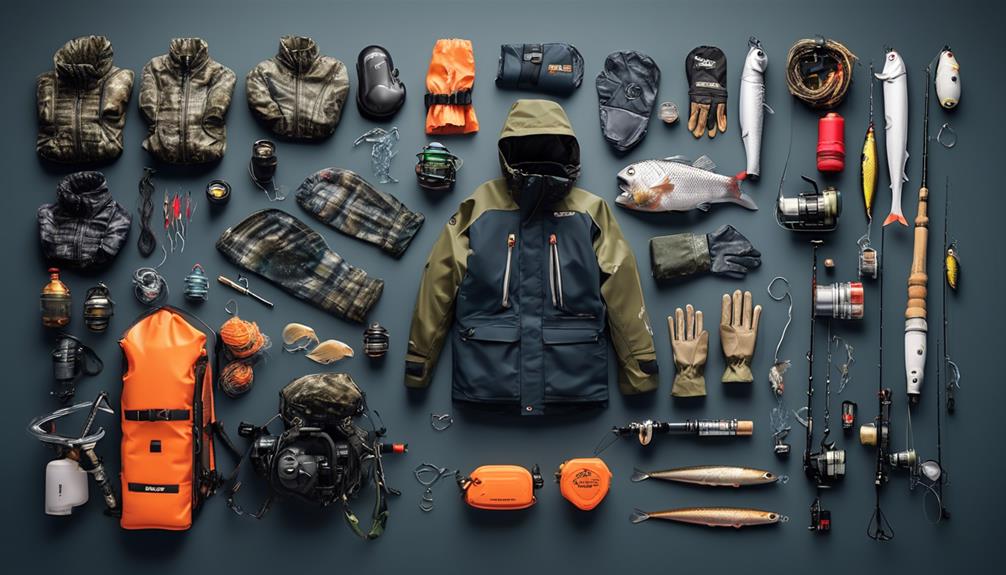Imagine effortlessly casting your line with a sleek, lightweight rod designed for precision and control, allowing you to effortlessly present your fly to even the most elusive trout.
The key to an enhanced fly fishing experience lies in the gear you use. From the moment you step into the water, the right equipment can make all the difference between a frustrating day and an unforgettable adventure.
But what exactly constitutes the optimal lightweight gear for this purpose?
Rods
When choosing a fly fishing rod, consider the weight and length that best suits your casting style and target fish. Rod selection is crucial for an enjoyable and successful fly fishing experience.
Lightweight materials have revolutionized the industry, offering anglers the perfect balance of durability and performance. When considering rod selection, it's important to take into account the type of casting techniques you prefer to use. Whether it's delicate presentations or long-distance casting, the right rod can make all the difference.
Modern fly fishing rods are often constructed from lightweight materials such as carbon fiber, making them easier to handle and reducing fatigue during long casting sessions. These materials also provide the durability needed to withstand the rigors of fly fishing, ensuring that your rod will last for years to come.
When selecting a rod, pay close attention to its weight and balance. A well-balanced rod will feel comfortable in your hand and allow for smooth, controlled casting motions.
Casting techniques play a significant role in rod selection. For precise and accurate casting, a sensitive, lighter rod may be preferred. On the other hand, when targeting larger fish or casting in windy conditions, a slightly heavier, more powerful rod might be the better choice. Understanding your casting style and the specific demands of your target fish will guide you toward the perfect rod for your needs.
Ultimately, a well-chosen fly fishing rod will enhance your overall experience on the water.
Reels
Constructed from lightweight materials such as aluminum and carbon fiber, fly fishing reels are designed to complement the balance and performance of modern rods. When it comes to enhancing your fly fishing experience, paying attention to your reel is crucial.
Here are some key aspects to consider:
- Reel Maintenance: Proper maintenance is essential to ensure the longevity and optimal performance of your reel. Regularly clean and lubricate the reel to prevent corrosion and ensure smooth operation. Check for any signs of wear and tear, and address any issues promptly to avoid potential damage.
- Upgrading Options: If you're looking to upgrade your reel, consider factors such as weight, balance, and durability. Upgrading to a lighter reel constructed from advanced materials can significantly reduce fatigue during long casting sessions. Additionally, look for reels with enhanced drag systems and smoother retrieval speeds for improved control and efficiency.
- Drag System and Retrieval Speed: The drag system is a critical component of a fly fishing reel, controlling the amount of resistance when a fish takes the line. Opt for reels with adjustable drag systems that provide a wide range of settings to accommodate different fish species and varying conditions. Furthermore, a higher retrieval speed can be advantageous when quickly reeling in and controlling the fish during intense battles.
Lines
To enhance your fly fishing experience, selecting the right fly fishing line is crucial for achieving accurate casts and effectively presenting your flies to the fish. When it comes to choosing the right line, consider the type of fishing you'll be doing and the species you'll be targeting.
For example, if you're fishing in freshwater for trout, a weight-forward floating line is a versatile option that can handle a variety of casting techniques. On the other hand, if you're targeting larger species or fishing in deep waters, a sinking line may be more suitable.
It's also important to match the line weight to your rod and reel. Most fly rods have a line weight recommendation printed on them, ensuring that the line is properly matched to the rod's capabilities.
Line maintenance is another crucial aspect of ensuring optimal performance. Regularly cleaning your line with a mild soap and water can help prolong its lifespan and maintain its casting abilities. Additionally, inspecting the line for any signs of wear and tear, such as nicks or cracks, is important to prevent breakage during casting.
When it comes to casting techniques, different lines may behave differently. Experimenting with various casting techniques, such as roll casting or double hauling, can help you understand how different lines perform and adapt your casting accordingly.
Understanding the nuances of your chosen line and practicing different casting techniques can significantly enhance your overall fly fishing experience.
Leaders
Selecting the right leader is essential for effectively presenting your flies to the fish and improving your fly fishing success. A leader is the clear monofilament or fluorocarbon line that's attached to the end of your fly line and is crucial for delivering your fly to the fish in a natural and convincing manner.
Here are some key considerations when it comes to leaders:
- Knot Tying: Properly tying the leader to the fly line and the tippet to the leader is essential for ensuring that your setup remains intact during the casting and when fighting a fish. The improved clinch knot, the double surgeon's knot, and the blood knot are reliable and effective knots for securing the leader connections.
- Tippet Selection: The tippet is the final section of the leader, and choosing the right tippet is important for presenting your fly naturally. It's crucial to match the tippet's diameter to the size of the fly and the conditions of the water you're fishing in. Thinner tippets are more delicate and are suitable for smaller flies and wary fish, while thicker tippets provide more strength and are better suited for larger flies and aggressive fish.
Flies
When choosing flies for fly fishing, consider the specific insects or baitfish that the fish in your target area are feeding on. Fly selection is crucial for a successful fly fishing experience. Different water conditions call for different fly types. For example, dry flies are ideal for calm, clear waters, while streamers or nymphs work well in faster, deeper waters. Matching the hatch, or selecting a fly that closely resembles the insects hatching in the area, is a fundamental fly selection technique.
Casting techniques play a significant role in fly fishing success. Proper presentation of the fly is often more important than the fly pattern itself. A drag-free drift is essential when using dry flies, while streamers may require a more aggressive stripping action to mimic a fleeing baitfish. Understanding the behavior of the fish and the food sources available to them can help you determine the best fly presentation strategies.
In addition to considering the type of water and the natural food sources available, it's essential to think about the time of year and the specific species of fish you're targeting. Different species have different feeding behaviors, and their preferences for certain flies can vary. By understanding the habits and habitats of the fish you're pursuing, you can fine-tune your fly selection and presentation techniques for a more successful and enjoyable fly fishing experience.
Waders
Consider the water depth and temperature when choosing waders for fly fishing to ensure comfort and protection during your fishing adventures. Properly fitting waders made from breathable materials are essential for a successful and enjoyable fly fishing experience.
When it comes to waders, maintenance and sizing are crucial. Here are a few tips to keep in mind:
- Wader Maintenance and Sizing
- Always check for leaks and punctures before heading out. Patch any holes promptly to prevent water from seeping in and affecting your comfort. Additionally, ensure that your waders fit properly to avoid any restrictions in movement while wading through the water.
- Wader Material and Breathability
- Choose waders made from high-quality, breathable materials such as Gore-Tex or neoprene. These materials allow perspiration to escape while preventing water from getting in, keeping you dry and comfortable throughout your fishing expedition.
- Proper Sizing for Comfort
- Select waders that provide enough room for comfortable layering underneath in colder temperatures. However, ensure they aren't too loose to avoid any unnecessary bulkiness that may hinder your movements. Finding the right balance between insulation and mobility is key to an enjoyable fishing experience.
Vests

To ensure your comfort and convenience during fly fishing, invest in a well-designed vest that complements your waders and allows easy access to essential gear while on the water. When selecting a vest, prioritize organization and comfort.
A vest with optimal organization ensures that all your gear is readily accessible, while comfort is crucial for those long days on the water.
Vest organization is essential for efficient fly fishing. Look for a vest with multiple pockets, including specialized compartments for fly boxes, tippets, and leaders. This ensures that your gear is neatly arranged, making it easy to find what you need without wasting time searching through cluttered pockets. Additionally, consider a vest with attachment points for tools such as nippers, forceps, and floatant holders. This feature allows you to keep essential tools within reach, further streamlining your fishing experience.
In addition to organization, vest comfort is vital for prolonged enjoyment on the water. Look for a vest with adjustable straps to ensure a snug yet comfortable fit. Breathable materials are also crucial, especially during warm weather or when hiking to remote fishing spots. Mesh panels or ventilation features can help keep you cool and prevent uncomfortable sweating.
Finally, consider the weight distribution of the vest. A well-designed vest distributes the weight of your gear evenly, preventing strain on your neck and shoulders, and allowing you to fish comfortably for extended periods.
Accessories
Enhance your fly fishing experience with essential accessories that streamline your gear management and improve your angling efficiency. These accessories not only enhance your performance but also provide essential protection from the elements.
- Fly Boxes, Storage: Invest in a quality fly box to keep your flies organized and easily accessible. Look for waterproof, durable options with secure closures to protect your flies from moisture and damage. Consider a fly box with adjustable compartments to accommodate various fly sizes and types.
Additionally, a lightweight sling pack or waist pack with multiple pockets can provide convenient storage for your fly boxes, leaders, tippets, and other essentials, keeping everything within easy reach without weighing you down.
- Sunglasses, Protection: Protect your eyes from harmful UV rays and improve your visibility on the water with polarized sunglasses. Look for sunglasses specifically designed for fishing, with features such as impact-resistant lenses and glare reduction. Polarized lenses not only enhance your ability to spot fish and read the water but also provide crucial protection from errant hooks and flying debris.
Choose sunglasses with a snug, comfortable fit and consider a floating retainer to prevent loss if they accidentally fall into the water.
With the right accessories, you can efficiently manage your gear and stay protected while enjoying your fly fishing adventures. These essential items won't only enhance your overall experience but also contribute to a more successful and enjoyable angling journey.
Frequently Asked Questions
How Can I Improve My Casting Technique to Make the Most of My Lightweight Gear?
To improve casting technique for lightweight gear, focus on accuracy and distance.
Practice proper wrist movement and timing to increase accuracy. Utilize the power of your rod to cast farther. Work on your body positioning and timing to achieve better distance casting.
Incorporate these techniques into your regular practice sessions. With dedication and practice, you'll see significant improvements in your casting technique, making the most out of your lightweight gear.
Are There Any Specific Types of Lightweight Gear That Are Better Suited for Different Types of Fly Fishing Environments (E.G. Rivers, Lakes, Streams)?
When fly fishing in different environments like rivers, lakes, and streams, it's essential to choose lightweight gear that suits each setting.
For rivers, consider a lightweight rod and reel for easy maneuverability.
In lakes, opt for gear with longer casting distances to cover more water.
In streams, focus on gear that allows for precise and delicate presentations.
Tailoring your lightweight gear to specific environments can enhance your fly fishing experience.
What Are Some Tips for Properly Maintaining and Caring for Lightweight Gear to Ensure Its Longevity?
To properly maintain your lightweight gear for fly fishing, there are several steps you can take:
- Start with proper cleaning after each use to prevent corrosion and damage. This includes rinsing your gear with freshwater and drying it thoroughly before storing it away.
- Utilize storage techniques that will help protect your gear and prevent wear and tear. For example, consider hanging your gear or using protective cases to keep it safe and in good condition.
- Be vigilant in addressing necessary repairs promptly. Regularly inspect your gear for any signs of damage or wear, and take the necessary steps to repair or replace any components that are worn out or broken.
- When choosing gear, it's important to consider the environmental impact. Opt for sustainable options whenever possible, such as gear made from recycled materials or produced using eco-friendly manufacturing processes.
- Additionally, consider the trade-offs between lightweight and heavy gear, and how they can affect different casting techniques. Lightweight gear can often offer advantages such as increased sensitivity and ease of handling, but it may not be suitable for all fishing situations. Consider the specific conditions and casting techniques you will be using, and choose gear that is appropriate for those circumstances.
Are There Any Specific Lightweight Gear Options That Are More Environmentally Friendly or Sustainable?
When it comes to environmentally friendly lightweight gear, you'll want to look for options made from eco-friendly materials and designed using sustainable techniques. These can include gear made from recycled or upcycled materials, as well as those utilizing sustainable production methods.
Keep an eye out for gear that minimizes environmental impact throughout its lifecycle, from manufacturing to disposal. Choosing such options not only enhances your fly fishing experience but also contributes to a healthier planet.
Can Lightweight Gear Be Used for All Types of Fly Fishing, or Are There Certain Situations Where Heavier Gear May Be More Appropriate?
When fly fishing in saltwater, lightweight gear is essential for ease of casting and maneuvering in the water. However, there are certain situations, like strong winds or large fish, where heavier gear may be more appropriate.
It's important to assess the conditions and the type of fish you're targeting to determine when to use heavier gear in fly fishing. Always consider the specific requirements of your fishing environment.
Conclusion
So there you have it – with the right lightweight gear, your fly fishing experience can be enhanced and enjoyable.
From rods to reels, lines to leaders, and everything in between, choosing the optimal gear can make all the difference.
So next time you head out to the water, make sure you're equipped with the best lightweight gear for a successful and comfortable fly fishing adventure.



